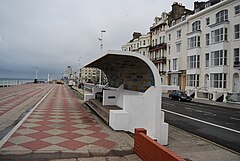St Leonard's-on-Sea
| St Leonards-on-Sea | |
|---|---|
 The seafront at St Leonards-on-Sea |
|
| St Leonards-on-Sea shown within East Sussex | |
| OS grid reference | TQ7909 |
| District | |
| Shire county | |
| Region | |
| Country | England |
| Sovereign state | United Kingdom |
| Post town | ST. LEONARDS-ON-SEA |
| Postcode district | TN37, TN38 |
| Police | Sussex |
| Fire | East Sussex |
| Ambulance | South East Coast |
| EU Parliament | South East England |
| UK Parliament | |
St Leonards-on-Sea (commonly known as St Leonards) has been part of Hastings, East Sussex, England, since the late 19th century though it retains a sense of separate identity. It lies to the west of central Hastings. The original part of the settlement was laid out in the early 19th century as a new town: a place of elegant houses designed for the well-off; it also included a central public garden, a hotel, an archery, assembly rooms and a church. Today's St Leonards has extended well beyond that original design, although the original town still exists within it.
The land that is now St Leonards was once owned by the Levett family, an ancient Sussex gentry family of Norman origin who owned the adjacent manor of Hollington, and subsequently by their descendants, the Eversfields, who rose to prominence from their iron foundries and widespread property holdings during Tudor times. Eversfields served as sheriffs of Surrey and Sussex in the 16th and 17th centuries and were later baronets before the family became extinct.
James Burton, a successful London architect who had developed large areas of Bloomsbury and the houses around Regent's Park, purchased land from the Eversfield estate to put into being his concept of a seaside resort. The land was part of Gensing Farm, and included a small wooded valley leading down to the sea. Work on the plan started in early 1826. It included a house for himself (West Villa: now 57 Marina); service areas were provided, such as shops and laundering (Mercatoria and Lavatoria), as well as public buildings for entertainment and the picturesque siting of villas amongst the wooded slopes and water of the central gardens, to be paid for by subscription.
In addition he persuaded the Turnpike Commissioners to have the road leading to St Leonards included in the scheme, and arranged for the road through Silverhill to be built so as to give access. Before he died in 1837 St Leonards (Royal Victoria) Hotel, the South Colonnade, an archway marking the town boundary with Hastings, and tall seafront houses (as far as 71 Marina) had also been completed. His grave is marked by a pyramid in the churchyard above St Leonard's Church. In 1850 his son Decimus (1800–1881) started the second phase of building, by acquiring more land and extending the development westward. He lived in the town for the remainder of his life.
...
Wikipedia

